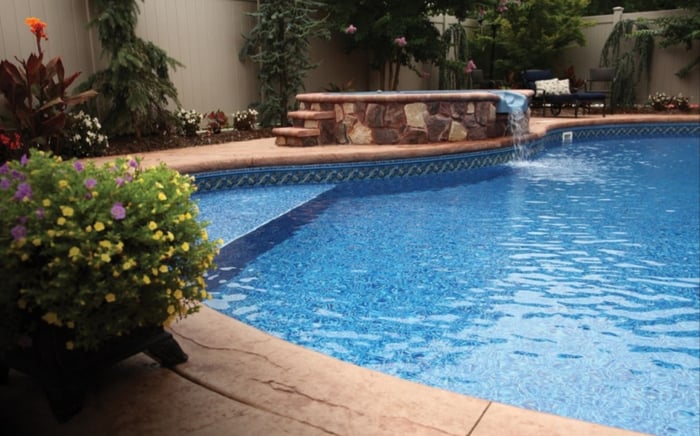How to Start Up a Saltwater Swimming Pool: A Complete Guide
Silky water, fewer chemical runs, and no lingering chlorine smell—those are just a few perks waiting once you dial in a salt-water system. Whether you’re brand-new to saltwater pools, reopening one for the season, or converting from a traditional chlorine setup, this guide walks you through the start-up process.
A salt-chlorine generator sanitizes your pool by converting dissolved salt into chlorine as water passes over titanium plates, so you no longer need to store or handle buckets of tablets or liquid bleach. Because the generator feeds chlorine at a steady rate, saltwater pools typically need less day-to-day chemical tweaking than tablet-fed pools. Swimmers also feel the difference: the lower chlorine peaks, combined with a mild saline solution, leave the water noticeably softer on skin and eyes.
What You Need to Start a Saltwater Pool
- Comprehensive test kit: Measures free chlorine, pH, total alkalinity, cyanuric acid (CYA), calcium hardness, and salt levels. Liquid or digital kits offer the most accurate results.
- Pool-grade salt (≥ 99% pure NaCl): Fine-grain, additive-free salt dissolves quickly and won’t stain surfaces. Most residential salt systems operate best around 3,200 ppm.
- Chlorine stabilizer (CYA): Helps protect newly generated chlorine from UV degradation. Maintain levels between 50–80 ppm for consistent performance.
- pH adjusters: Use muriatic acid or soda ash to keep pH between 7.4 and 7.6, reducing the risk of scaling or corrosion.
- Salt chlorine generator (SCG): Choose a unit rated for 1.5 to 2 times your actual pool volume. This prevents the cell from running at full capacity continuously.
- Reliable circulation system: Ensure your pump and filter can cycle the entire pool volume every 8–12 hours for optimal water quality and chlorine distribution.
- Cell cleaning solution: Use a 4:1 water-to-acid mix (or manufacturer-recommended tablets) to remove calcium buildup without harming the generator plates.
- Protective gear: Wear chemical-resistant gloves, safety goggles, and use a dedicated plastic scoop when handling salt or chemicals.
Pro tip for existing pools: Before adding salt, backwash or deep-clean the filter to start with a blank slate.
Starting a New Saltwater Pool: Step-by-Step
- Fill the pool with fresh water
- Use municipal water when available for best quality.
- If using well water, consider pre-filtering for iron or manganese.
- Test and balance alkalinity first
- Target range: 80–120 ppm to help stabilize pH.
- If TA is low: Add baking soda.
- If TA is high: Add acid in small amounts while aerating to reduce levels gradually.
- Adjust pH to 7.4–7.6
- Aim closer to 7.4 for new plaster or quartz finishes to help reduce early scaling.
- Set calcium hardness to 200–400 ppm
- If water is soft: Add calcium chloride to boost levels.
- If water is very hard: Consider partial drain and refill to lower hardness.
- Establish CYA to 50–80 ppm
- Pour the dry, granular stabilizer directly into the skimmer, scattering it into the water flow.
- For more control, an alternative method is to dissolve stabilizer in a sock placed in the skimmer basket.
- Calculate and add salt
- Test your fill water with a salt strip or digital reader to find the starting salinity.
- Use the chart on the salt bag or your generator’s manual to determine how much salt is needed.
- If you need to determine your pool's gallon capacity, use our Pool Gallon Calculator.
- With the pump running, spread salt over the deep end in wide arcs.
- Brush the pool floor thoroughly until no salt is visible to prevent staining or surface damage.
- Circulate for 24 hours
- Allow salt to fully dissolve and mix throughout the pool.
- Undissolved salt can damage vinyl or fiberglass surfaces.
- Install and commission the salt chlorine generator (SCG)
- Mount the control panel at eye level, out of direct sunlight.
- Install the cell after the filter and heater on the return line.
- Ensure bonding and grounding meet local electrical code.
- Set the output to 50% for the first week of operation.
- Verify chemistry after one full turnover
- Adjust chlorine levels by increasing or decreasing the SCG output in 10% steps.
- Monitor and fine-tune pH daily during the first month.
- Dive in when free chlorine stabilizes between 2–4 ppm
- The water should be clear, odorless, and comfortable for eyes and skin.
Pro Tip: First-time startup will take a full pool circulation cycle (~24 hours).
Converting a Pool to Saltwater: What to Know
- Generator sizing: Choose a larger cell than your exact pool volume. Undersized systems must run constantly, which reduces their lifespan.
- Surface compatibility: Vinyl and fiberglass are fully compatible. Plaster surfaces work well too, but galvanized steel components should be paired with sacrificial anodes to prevent corrosion.
- Equipment check: Replace copper heat exchangers, outdated tablet chlorinators, or any sensors not rated for saltwater before converting.
- Chemical purge: If the pool was previously treated with biguanide, conduct a peroxide and chlorine rinse, then vacuum debris to waste.
- Install in the right order: Plumbing should follow this sequence: pump → filter → heater → salt cell → return. Installing the generator before the heater can void equipment warranties.
- Add salt gradually: Increase salinity in two or three stages over 48 hours, testing between each to avoid overshooting your target.
- Monitor the first month closely: Some residual chloramines may linger during the transition; occasional non-chlorine shock treatments can help stabilize free chlorine levels.

Saltwater Pool Chemistry Basics
| Parameter | Ideal Range | Purpose |
| Salt | 2,700 - 3,400 | Enables efficient chlorine generation |
| Free Chlorine | 2 - 4 ppm | Sanitizes against algae and bacteria |
| pH | 7.4 - 7.6 | Optimizes swimmer comfort and generator longevity |
| Total Alkalinity | 80 - 120 ppm | Buffers pH swings |
| Cyanuric Acid | 50 - 80 ppm | Protects chlorine from sunlight |
| Calcium Harness | 200 - 400 ppm | Prevents etching and scale |
Common Saltwater Startup Mistakes to Avoid
- Adding salt too early: Always balance total alkalinity (TA), pH, and cyanuric acid (CYA) before adding salt. Doing it out of order can throw your water chemistry off and lead to constant rebalancing.
- Skipping the brush-down: Salt granules settle quickly and can damage vinyl, fiberglass, or smooth plaster if not brushed into circulation. Spend at least 10 minutes brushing after each salt addition to protect surfaces.
- Turning the cell on before salt dissolves: Undissolved salt near the cell can trick it into reading low salinity, causing it to run at full output unnecessarily. This reduces the lifespan of the generator plates.
- Ignoring high pH drift: Salt systems naturally raise pH through the electrolysis process. Check and adjust pH daily during the first two weeks to prevent scaling on the cell and pool surfaces.
- Using table or rock salt: Regular table salt and rock salt contain additives like iodine or anticaking agents, which can cloud water and stain finishes. Only use pool salt or high-purity food-grade solar salt.
- Failing to bond and ground: Without proper electrical bonding and grounding, stray voltage can cause metal parts—like ladders, handrails, and lights—to corrode prematurely.
Maintenance Tips After Startup
Weekly:
- Test chlorine and pH: Adjust the salt cell output or add muriatic acid to stay within the ideal ranges of 2–4 ppm chlorine and a pH of 7.4–7.6.
- Empty baskets & skim the surface: Keeping skimmer and pump baskets clear ensures strong circulation, reducing the risk of algae in low-flow areas.
Monthly:
- Check salt and total alkalinity: Rain or splash-out can dilute salt. Use baking soda if total alkalinity (TA) drops below 80 ppm.
- Inspect the cell window: Look for signs of scale buildup—white flakes or crystals—on the plates or housing. Early cleaning prevents damage.
Quarterly:
- Deep-clean the salt cell: Soak in a recommended cell cleaning solution (or 4:1 water-to-acid mix) for 15 minutes, rinse thoroughly, and reinstall.
- Brush walls and steps: Even with balanced water, a light film can form, especially on textured surfaces. Brushing keeps them clean and clear.
Seasonally:
- Shock after heavy use or storms: A non-chlorine oxidizer helps restore water clarity and remove contaminants without overshooting chlorine levels.
- Lubricate O-rings and inspect gaskets: Saltwater can dry out rubber parts over time. Apply fresh silicone lubricant to seals to prevent leaks and extend equipment life.
Routine keeps surprises to a minimum. Plan the work, then enjoy the water.
Saltwater Pool Startup - FAQs
How long does the entire saltwater pool startup process take?
- Expect it to take two to three days. Day one is for balancing the water, day two for dissolving the salt, and day three for fine-tuning the system and stabilizing chlorine levels.
Can I swim in the pool immediately after adding salt?
- It’s better to wait. Although dissolved salt isn’t harmful, the pool isn’t considered safe until the salt chlorine generator has had time to produce a stable sanitizer level. Don’t swim until the salt is fully dissolved and your test kit shows Free Chlorine between 2–4 ppm.
What happens if I add too much salt to my pool?
- Salt levels above 5,000 ppm can accelerate corrosion and reduce the life of your generator cell. To fix it, partially drain the pool and refill with fresh water, then retest.
Do I need to shock my saltwater pool every week like a traditional chlorine pool?
- No. A salt system provides a steady, low-level supply of chlorine. Shocking is only needed after heavy use, storms, or if you notice signs of algae or cloudy water.
Can I use regular table salt for my pool startup?
- Avoid it. Table salt contains additives like anti-caking agents and iodine, which can cloud the water and clog the salt cell. Stick with high-purity pool salt specifically labeled for swimming pools.
We hope you've found this guide helpful! If you still have questions or want to learn more check out our other salt blogs below or give us a call at 901-372-1773. Stay salty!
- Chlorine vs. Saltwater vs. Mineral System Pools: Pros and Cons
- Everything You Ever Wanted to Know About Saltwater Pools
- How to Maintain a Saltwater Swimming Pool
- How to Convert a Chlorine Pool to a Saltwater Pool
- Saltwater Above Ground Pools: A Buyer’s Guide
- How To Clean the Salt Cell on Your Saltwater Swimming Pool
- How To Troubleshoot Problems With Your Salt Cell
- What is the Benefit of Switching to Salt Water?









